Of all the personalities with whom he came into contact in a lifetime of football, Peter Chisnall retains a soft spot for his first coach…….
“She was a Catholic nun – Sister Mary Elizabeth Clancy………I remember she used to tuck her long, flowing, black habit into her belt and spear out accurate left-foot passes to us little tackers,” ‘Chizza’ recalls.
“I was in my forties when I returned to a school re-union at St. Mary’s Primary School, and caught up with her again……. She told me she’d got to see me play a couple of games at the MCG…….then presented me with a scrapbook that she’d compiled, detailing a lot of my footy highlights. I was tickled pink ………”
………………………………………………………………………………………………………………………………………….
‘Chizza’s’ a ‘people person’……..friendly, enthusiastic, exuding positivity, and blessed with a liberal dose of charisma. And boy, does he love a yarn!……I’d promised not to annoy him for too long…….Two and a bit hours later, we were still at it, despite him facing a lengthy drive back home to Numurkah…….
He does some work for the Justice Department these days; supervising offenders on Work Projects. He had a crack at retirement for a while, he explains, but drove himself up the wall with boredom. So he started going around to jails giving talks to prisoners. Then this job was offered to him. He loves it….. Loves being involved, and helping people.
His long-term trade was as a Butcher, but he’s also been a Grain Representative, a Promotions Officer, had stints on talk-back Radio and TV, and operated a corner-store . He and his wife Helen bought a run-down pub in Burrumbuttock many years ago, built it up and sold it, then ran the Tungamah Hotel for more than a decade. I can just picture him engaging in repartee with the patrons from behind the bar of a pub. They’d have stayed for hours, I’m sure.
But I’m keen to explore ‘Chizza’s’ footy resume’….. that’s a fascinating story in itself……………
………………………………………………………………………………………………………………………………………….
The Chisnall’s are a famous Corowa footballing family. Two of Pete’s uncles were part of the Spiders’ first premiership, way back in 1932. His dad Bill, who lost a fair bit of his footy to the war years, also played a lot of games, and later coached South Corowa. An older brother Adrian had been a star, so expectations were high when the lad debuted, aged 16.
“John Hoiles, the ex-Footscray defender, was coaching at the time. ‘Hoilesy’ could be pretty brutal, but he was good for a young fellah like me. He kept hammering into us to ‘put your head over the ball’. We were short on talent though, and won just two games in each of my first two seasons.”
“Thankfully, we picked up some classy recruits in 1968; the club was able to snap up Richmond captain Freddie Swift as coach, and ‘Hoilesy’ agreed to stay on as a player. A big change came over the place,” he recalls.
Peter had done a pre-season at North Melbourne, and played on match-permits in the opening two rounds – a win at Footscray, and a 19-point defeat at the hands of Essendon.
“It was weird to be playing on blokes like Barry Capuano and Russell Blew. You’d been running around collecting their footy card only a couple of years earlier. But ‘Swifty’ and ‘Bluey’ Crisfield came down to see North, and said they’d like me to go back, play the season at Corowa, and return for good the next year. So that’s what I did.”
It proved a dream season for ‘Chizza’. He played in the Ovens and Murray’s Country Championship win over Wimmera, and was a constant source of drive on the wing for the Spiders, as they surged dramatically towards an improbable finals berth.
Their Round 18 clash with Wangaratta carried huge stakes, as the clubs were vying for the vacant fourth spot. Corowa needed to get up by seven goals or more…..They stormed home to win by 92 points.
Then they overcame North Albury and Myrtleford in successive weeks, thus earning the right to challenge powerful reigning premier Wodonga in the Grand Final.
It was a classic. The Dogs led by 26 points at quarter-time, but Corowa, with a strong breeze at their back, booted six goals to nil in the second to gain the ascendency. It became a nip-and-tuck affair from then on.
In the dying stages, Wodonga maintained a slender lead, but a superb 50-metre goal from Kevin Witherden and a ‘pearler’ from the pocket by left-footer Lindsay Jacob, sealed the Spiders’ first flag for 36 years…….
………………………………………………………………………………………………………………………………………….
Peter returned to Arden Street and established himself in the North Melbourne side over the next two seasons, but by 1971 the winds of change were blowing. Brian Dixon had taken over as coach and proceeded to exert his authority.
“I was asked to attend a meeting, and when I walked in he said: ‘I want to see you upstairs.’ I thought ‘here’s trouble’. He greeted me with: ‘Well, make up your mind. Do you want to be a League footballer….. or a butcher for the rest of your life ?’”
“I thought that was a bit harsh. Here I was, starting work in the Butcher Shop at 4am to cram in footy training. Along with four or five other players who’d been given a similar directive, I walked out on North.”
He moved to Sandringham without a clearance, and played with the Zebras for the next two seasons. When the VFL and VFA declared a Morotorium to eradicate their clearance stand-off, he was forced to serve a one-year penalty.
By now Peter and Helen had moved to Albury. They’d recently lost their first-born, Brad, through cot-death, and were rapt to be back near their respective families. He acted as a runner for Albury coach Timmy Robb in 1973.
But a visit from a North delegation, Ron Barassi, Alan Killigrew and Ron Joseph, changed their path. ‘Chizza’ was about to embark on the ride of his life……
“ ‘Barass’ said: ‘Have you thought about playing VFL footy again ? I can tell you, if you come down and do a pre-season, you’ll play in my team.’ That was good enough for me.”
“I’d always considered myself a bit of a battler. I had speed, and could mark, but the game didn’t come naturally to me.”
“We had a pack of good small men around the middle, led of course, by Barry Cable. Our job was capitalise on the ruckwork of big Mick Nolan, who had the marvellous ability to direct the ball anywhere.”
“It was unbelievable to be a part of North’s journey, as we got to our second-ever Grand Final, then in 1975 knocked over Hawthorn, to win the Club’s first flag.”
What obviously also appealed to Barassi was that his winger; a popular, engaging figure within the club, played on the edge once he crossed that white line.
He had a day out in the Grand Final, collecting 22 kicks, 5 marks, dishing out 5 handballs, and continually pumping the pill to the point of the square.
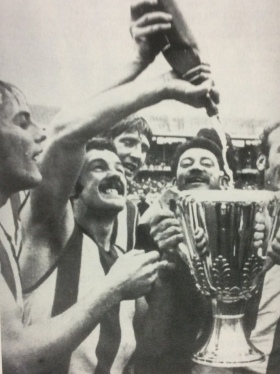
‘Chizza’ also featured in the ‘76 Grand Final, in which the Hawks were able to exact their revenge. But in the first practice match of 1977 his 80-game League career came to a sad end, when he was involved in a head-on collision and suffered a fractured skull.
That setback may have put paid to his time at the top, but over the next thirty years, he was to embark on a coaching odyssey which would further re-inforce his footballing CV………
…………………………………………………………………………………………………………………………………………..
The first stop was to Tasmanian club New Norfolk, whom he guided to a Preliminary Final in 1978.
“I was on a two-year contract, but was released from it when Dad got badly injured in a truck accident, and needed my support. I made a vow that I’d return to Tassie one day.”
“But I’d no sooner arrived back home when Hec Francis, who’d been tied up with Rutherglen, approached me and said: ‘Look, we’re gone. We’re going to amalgamate with Corowa and we’d like you to be Corowa-Rutherglen’s first coach.”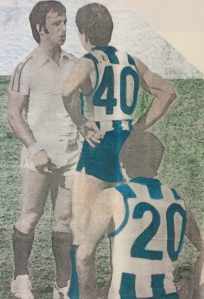
“They were three terrific years. I also coached the O & M side in ‘79, and combined the role with a job as North Melbourne’s Zone Development Officer.”
After working with Barastoc Feeds for several years, he was back operating a butcher shop in Port Melbourne when the famous VFA club had a coach pull the pin on the eve of the 1986 season.
“I’d been doing some Skills Coaching at Essendon, but Port asked if I’d slip into the job. It was a privilege to be involved with such an iconic Club……..They’re great people. I handed over the reins to a Port stalwart, Georgie Allen, at season’s end.”
‘Chizza’ fitted in one final season as a player at East Ringwood, aged 39, as a favour to an old Port Melbourne mate, ‘Buster’ Harland. He then moved on to coach Old Caulfield Grammarians for two years.
He honoured his promise to return to New Norfolk, as non-playing coach in 1990. They’d been on the brink of bankruptcy, and had lurked around the bottom reaches of the ladder for several years.
The Chisnall arrival inspired great optimism and the Eagles, playing with renewed intensity, headed the ladder at one stage, before fading out in the Elimination Final. He worked on morning radio with TTT-FM, made regular appearances on TV, and coached the Tasmanian State side.
After concluding his three-year stint with New Norfolk, he moved north to coach State League Club Launceston for two seasons.
Completing the full circle, he and Helen settled back in the North-East, and he was snapped up by Yarrawonga to succeed Peter Foster in 1996.
Being back in the O & M environment appealed to ‘Chizza’ after a 15-year hiatus, but the Pigeons were on a ‘downer’ at the time.
“I decided to give the kids every opportunity, but became frustrated, and butted heads with a few people around the place. Suffice to say, I was unable to make a difference,” he says. Part of the way through his third season at the helm, he and the Club parted ways.
However, the ‘coaching bug’ continued to itch. He spent two years with Mulwala and one at Devenish, before the 350-game Chisnall coaching journey drew to its conclusion………
………………………………………………………………………………………………………………………………………
Peter and Helen’s two younger boys chose divergent paths in life. Grant studied at Duntroon, became an Army Captain, and served at several overseas hot-spots . Guy, who’s now involved in the meat industry, enjoyed a fine footy career, played in Corowa-Rutherglen’s 2003 premiership side and won a B &F with the Roos.
The baby of the family, Natalie (Ramsdale) still plays Queensland State League Netball with the Whitsunday Sharks
The grandkids are now his pride and joy, but he still finds time to sate his unquenchable thirst for football.
Next month, along with hundreds of old Kangaroos, ‘Chizza’ will celebrate North Melbourne’s 150-Year Anniversary. He’s looking forward to being back in the thick of the action……………… Continue reading “‘CHEWING THE FAT WITH ‘CHIZZA’………”
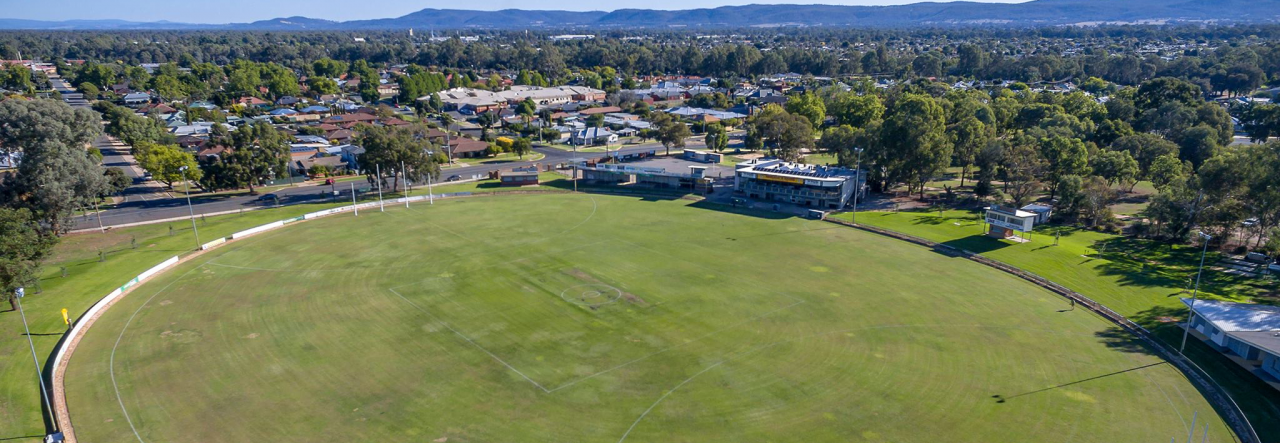
 ed footy ‘nut’. He was 13 when he played in the first of two flags for the Wanderers. A year later he was the League Best & Fairest.
ed footy ‘nut’. He was 13 when he played in the first of two flags for the Wanderers. A year later he was the League Best & Fairest.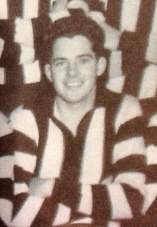

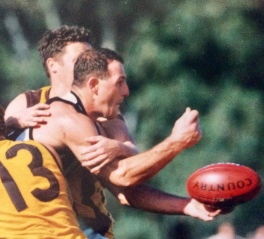





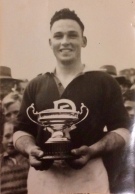




 Reagan ). There are also 17 grandkids and eight ( soon to be 12 ) great-grandkids, so the Sandral footy dynasty is set to continue.
Reagan ). There are also 17 grandkids and eight ( soon to be 12 ) great-grandkids, so the Sandral footy dynasty is set to continue.




